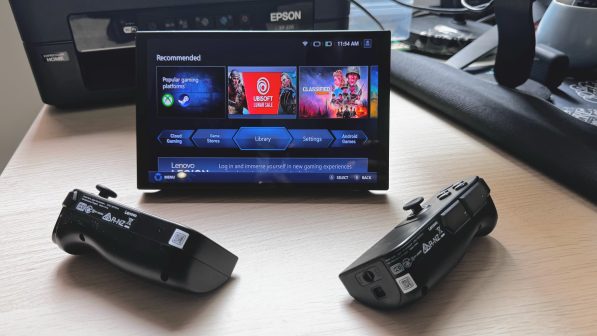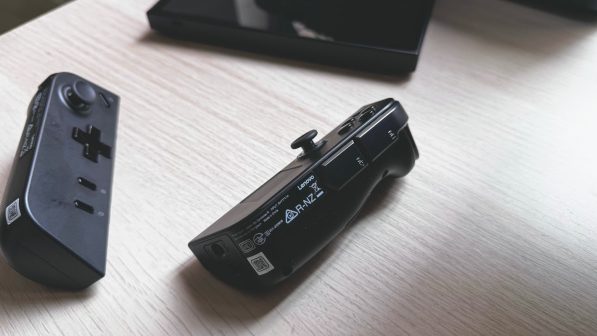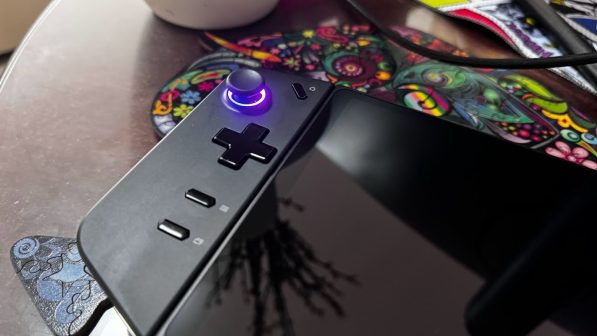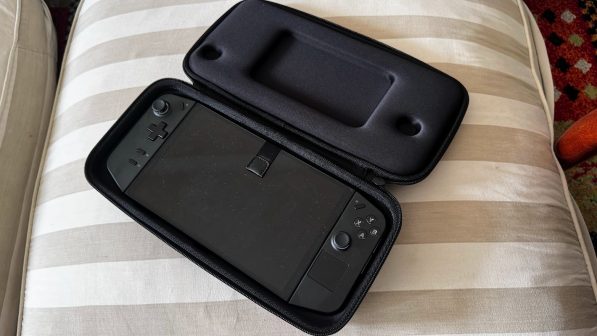In 2024, there might be a console war, but this time it will be with handheld gaming PCs. It all started with Valve’s SteamDeck, which was followed by Asus ROG Ally, but the new Lenovo Legion Go has entered the battlefield as the latest challenger.
The Legion Go is priced at $1500, making it the most expensive of the bunch and $400 more than the Asus ROG Ally. But it’s also the biggest and most powerful, with an 8.8-inch QHD display that runs at 144Hz and has a peak brightness of 500-nits. It also features detachable controllers and a kickstand, just like the Nintendo Switch, allowing players to relax and play without straining their arms.
Inside the Legion Go, you’ll find the AMD Ryzen Z1 Extreme APU, which is also present in the ROG Ally. While the performance isn’t significantly different between the two devices, Lenovo has added some clever new features that the Ally lacks, such as the built-in kickstand, making it stand out.
In this review, I’ll be sharing my experience playing most of my favorite games on the Legion Go, both at home and on the go. I won’t dive into the technical details, performance, or thermal modes, as there are already plenty of articles and videos covering those aspects. So, let’s get into it!
Design and features

The first thing you notice about the Legion Go is how big it is. While the ROG Ally feels almost perfectly balanced at 608g, the Legion Go is at least 250g heavier for a total weight of 854g. This is a weight your arms will definitely feel after very short period of gaming.A lot of the size is thanks to its 8.8-inch display and large, detachable controllers.
It dwarfs the ROG Ally in comparison and there’s no getting around how big it feels to hold. You will need to rest your arms on your lap or a desk while using it for any extended period. So it’s a good thing that the Legion Go has a built-in kickstand so you can prop it up on any stable surface. The kickstand has a great range of motion and is nice and firm.
That said, the Legion Go isn’t uncomfortable to hold. The TrueStrike controllers have the right curves that makes them easy to grip firmly and securely. Each controller is detachable at the press of a button but I did find it odd they don’t slide off but rather just pop out. Putting them back never quite felt natural; especially so on my unit where the right controller was always a little bit wobbly no matter how I inserted it.
Each TrueStrike controller has a wealth of buttons and triggers that can all be remapped in Lenovo software. The right controller has the unique trick of transforming into a joystick for more precise controls in FPS or flying sims. Lenovo includes a disc-like attachment that the TrueStrike controller slots into for this purpose. I thought it would be rather gimmicky but after using it for a little bit, it became my preferred way to play shooters on the Legion Go.
There’s two dedicated Legion Space buttons at the top of each controller; One opens the full Legion Space and the other opens up a Legion settings fly out. In the fly out, you get a number of controls for tweaking performance profiles, changing resolution and more. You also get some quick, handy shortcuts like Alt-F4 which surprisingly, you will need a lot.
I also like the touchpad on the bottom of the TrueStrike controller which makes navigating Windows on the Legion Go a whole lot easier. It’s got a little bit of haptic feedback which really helps with interactions. The rest of the controls live on the main tablet portion of the Legion Go.
There are two USB Type-C 4.0 ports, one on top and the other below; both support DisplayPort 1.4 and Power Delivery 3.0, which means you can power the Legion Go while also connecting other peripherals like a USB dock or monitor.
There’s dual 2W speakers on top which sound fine, nothing as rich and bold as the Ally but they do get the job done. Thankfully, there’s a 3.5mm audio port for you to connect agood headset. Alternatively, you can use a wireless USB or Bluetooth headset.
Powering the the Legion Go is the same AMD Ryzen Z1 Extreme processor with RDNA 3 Graphics that we got in the ROG Ally. This is mated to 16GB of LPDDR5X 7500Mhz memory, upto 1TB M.2 SSD and a MicroSD card slot for extra storage.
However, this is enough power to run AAA games at 30fps on the lowest settings and they will look stunning on the 8.8-inch, 2560×1600 IPS display. The display has a 144Hz refresh rate too with adaptive sync support so stuttering and screen tearing was never an issue for me.
It also gets plenty bright, maxing out at 500-nits which is good for outdoor use. It’s got great contrast and colours look lovely in games and media. The display is covered with Gorilla Glass, the same stuff on our smartphones and it seems to be fairly resilient to scratches. Smudges are another issue though as this is a 10-point touch screen that you will be touching a lot to get around Windows 11.
Software and UX

Like other handhelds, the Legion Go runs on Windows 11 operating system which allows you to access every major game and launcher. As with the Ally, that comes with plenty of its own issues as a poorly touch-optimised OS. Lenovo tries to cover this up with its Legion Space software overlay which is honestly one of the worse ones I’ve encountered.
Not only did it exaserbate the headaches of navigating Windows, but itself was a pain to use as it often wouldn’t respond to the TrueStrike Controllers. Launching items from the Legion Space would often change windows that wouldn’t respond to my inputs, forcing me into all sorts of shenanigans to get the right window front and center. Being touch, there’s no easy way to Alt-Tab which is quite frustrating.
Additionally, after adding my launchers and games, the Legion Space doesn’t differentiate between games and launchers; mashing everything into one large mess of tiles. That wouldn’t be so much of an issue if it didn’t keep wrongly mismatching my games with wrong icons!

One of the biggest problems, ultimately is how this poorly this launcher, launches stuff. I gave up using the controllers to navigate the interface which requires a double tap(Windows, OMG) and this proceeds to launch the game in windowed mode, usually with half the window cut off.
Trying to wrestle game windows was often annoying and I would be forced to call up the Alt-F4 shortcut to quit games and try launching them outside of Legion Space. Overall, the software experience on the Legion Go was worse for me than on the ROG Ally but maybe they’ve fixed all this by the time you read this.
Performance and gaming.

Okay, let’s talk about actually playing games, if you successfully launch them. Performance-wise, there are just way to many permutations of resolutions, graphical settings, power and thermal profiles to set a standard for every user. And combined with the kind of games that you would personally play, variances in performance will be huge.
That said, I did put the Legion Go through some standard synthetic benchmarks as well as game benchmarks. I ran these using the default Performance and Power Saving presets that come installed on the Legion Go. You can also create your own performance profile with a variety of custom fan and voltage settings.
As expected, the Legion Go performs quite similarly to the ROG Ally since they share the same guts. You can look at the performance charts to get a clearer picture. The main differences would come because of screen resolution as the Legion outputs a higher 1600p than the Ally’s 1080p. But when all things are equal, the two perform almost identically.
The Legion Go can run at a maximum total power output of 30W but doing so will definitely kill your battery in short order. In my testing, playing Diablo IV at low settings in 1080p, the battery drained in a little over 1 hour. However, playing something lighter like Planet of Lana or Hollow Knight, I was able to get the Legion Go to last three hours. So, your mileage will vary.
| Game | Legion Go | ROG Ally | |
| Shadow of Tomb Raider | 37 | 41 | |
| Red Dead Redemption 2 DLSS | 58 | 57 | |
| Forza Horizon 5 | 80 | 64 | |
| Metro Exodus Enhanced | 19 | 20 |
Fan noise isn’t terrible but I was most certainly more aware of the fans in the Legion Go than with the Ally. It’s not experience breaking but I did feel self-conscious gaming on the couch next to my wife who was trying to watch a tennis match. She definitely gave me a few concerned glances every time she heard the fans.
I found my sweet spot around the 20W mark and running games at 1080p resolution with some thoroughly researched best settings. Then I was able to get acceptable 40-50fps with a great looking game and without the battery dying on me for at least 3 hours. Even then, games like Starfield and Avatar: Frontiers of Pandora were just not as palatable unless the Legion Go was running at full power.
The user experience on the Legion Go is quite clunky, which was my biggest challenge while gaming on it. And because of this, I often hesitated to pick it up and play because there was always some issue or hiccup that would end up wasting my time. It was quite frustrating when games didn’t recognize the controllers, and the fact that it doesn’t support Quick Resume like consoles do made it impossible to snack game, which is one of the main attractions of a handheld console.
Verdict

The Lenovo Legion Go is a new entrant in the handheld gaming PC market. While it has some interesting features such as detachable controllers, kickstand and a large, sharp screen, it falls short in a few areas. It does not offer any significant improvement in performance or battery life compared to its cheaper competitor, the ROG Ally.
The overall user experience is also problematic, with many workarounds and headaches that made me feel discouraged to use the Legion Go. It failed to meet my need for a handheld device that I could use for quick gameplay without wasting too much time trying to get into the games.
One of the biggest issues with these consoles is Windows 11, which is still a pain point. I believe that the Legion Go would be much better if it used Valve’s SteamDeck OS instead. While I appreciate the idea behind the Legion Go, it needs to work on improving the user experience and Windows 11 compatibility. For now, the ROG Ally at $1000 is still the better option for Australians looking for a handheld PC, unless you can get your hands on a SteamDeck OLED.
Lenovo Australia kindly loaned the Legion Go to PowerUp! for the purpose of this review

















